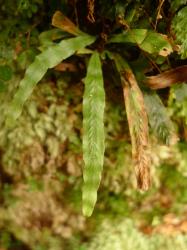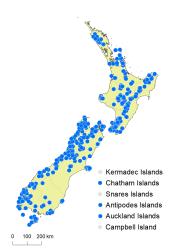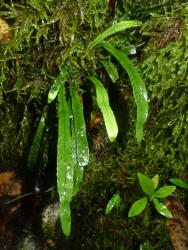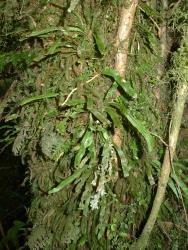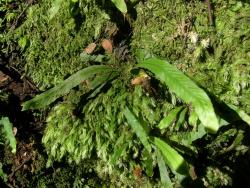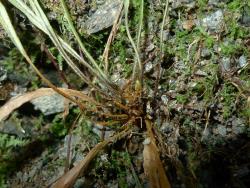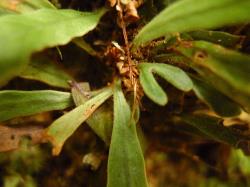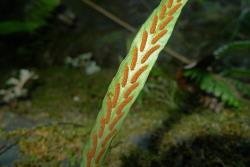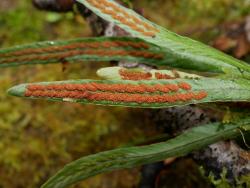- Taxon
- Gallery
- ≡ Grammitis billardierei Willd., Sp. Pl. 5(1), 139 (1810) – as billardieri
- ≡ Polypodium billardierei (Willd.) C.Chr., Index Filic. 513 (1906) nom. illeg., non Polypodium billardierei R.Br. 1810
- = Grammitis australis R.Br., Prodr. Fl. Nov. Holland. 146 (1810)
- ≡ Polypodium australe (R.Br.) Mett., Abh. Senckenberg. Naturf. Ges. 2: 36 (1857) nom. illeg., non Polypodium australe Fée 1852
- = Grammitis humilis Hombr. in Hombron & Jacquinot, Voy. Pôle Sud, Bot. t. 2, fig. H (1843)
Rhizomes erect to short-creeping, bearing scales. Rhizome scales ovate to narrowly ovate, 1.6–7.3 mm long, 0.4–1.8 mm wide, pale brown, concolorous, non-clathrate. Stipes indistinct, winged almost to base, hairy. Stipe hairs sparse to abundant, white to pale red-brown, 0.1–1.6 mm long. Fronds undivided, linear to narrowly elliptic, 20–245 mm long, 2–11 mm wide; apices acute to obtuse; margins entire; bases attenuate to an indistinct winged stipe; both surfaces pale green; herbaceous to coriaceous; glabrous or bearing sparse hairs up to 1.3 mm long on the margin, midrib and lamina surface. Hairs either setae, or branched hairs with setiform branches. Hydathodes usually absent or rarely present. Sori elliptic, sometimes curved, elongated along veins, oblique, 1.5–9 mm long, in 1–36 pairs, in mid to upper part of lamina, lacking hairs. Sporangia 140–270 µm long; spores 18–36 µm diameter.
Notogrammitis billardierei is easily the most common and variable species of the genus in New Zealand. It is characterised by its erect or short-creeping rhizome, relatively large fronds, lack of distinct stipes, hairs largely confined to the base of the frond, and absence of hairs in the sori. Plants with few hairs on the frond can be confused with N. angustifolia, but generally have larger fronds (20–245 mm long, 2–11 mm wide; cf. 15–220 mm long, 2–7 mm wide), and longer, oblique sori (up to 9 mm long, cf. up to 5 mm long), together with different hair types. Plants with short-creeping rhizomes can be mistaken for N. givenii, but the latter generally has long-creeping rhizomes, distinct stipes, obovate rather than narrowly elliptic laminae, and shorter fronds (9–115 mm long).
North Island: Northland, Auckland, Volcanic Plateau, Gisborne, Taranaki, Southern North Island.
South Island: Western Nelson, Sounds-Nelson, Marlborough, Westland, Canterbury, Otago, Southland, Fiordland.
Chatham Islands, Solander Island, Stewart Island, Antipodes Islands, Auckland Islands.
Altitudinal range: 0–1400 m.
Notogrammitis billardierei occurs in lowland and montane areas throughout much of the North Island from Kaitāia to Wellington, but is apparently absent from inland Taranaki and the east coast. It ranges from near sea level, but is mostly found above 300 m, and up to 1300 m near Ohakune and in the Ruahine and Kāweka Ranges. In the South Island it is common in lowland to subalpine habitats throughout the western part of the island, but is much less common in the east, and absent from much of south Canterbury and Otago. It reaches almost 1400 m on Mt Torlesse, Canterbury, but descends to sea level in Fiordland and the subantarctic islands.
Also Australia (Queensland, New South Wales, Victoria, Tasmania).
Notogrammitis billardierei is found in podocarp, broadleaved, beech and coastal forest, and in subalpine scrub. It grows as an epiphyte on forest trees as well as on roots, rotting logs, mossy rocks and banks, under rock overhangs, on root plates, and on the ground. It has been recorded growing on Blechnum discolor, Cyathea smithii, Dicksonia fibrosa, D. squarrosa, Ackama rosifolia, Beilschmiedia tarairi, Brachyglottis elaeagnifolia, Elaeocarpus dentatus, Fuchsia excorticata, Griselinia littoralis, Ixerba brexioides, Knightia excelsa, Lepidothamnus intermedius, Libocedrus plumosa, Metrosideros robusta, M. umbellata, Olearia colensoi, Podocarpus laetus, P. totara, Prumnopitys ferruginea, Pseudopanax crassifolius, Quintinia serrata, Weinmannia racemosa, W. sylvicola, and species of Nothofagaceae.
There is convincing evidence for very rare hybridisation between N. billardierei and N. heterophylla (CHR 215640, Parris 1977), and there may also be occasional hybrids between N. billardierei and N. angustifolia (CHR 178291, 189609, 214621, 387076). A single collection (WELT P027882) has the frond morphology of N. billardierei but the soral hairs of N. patagonica and is likely to be a hybrid between the two species.
n = 37 (Brownlie 1958 – as Grammitis billardierei).
Perrie & Parris (2012) showed that, based on chloroplast DNA sequences, material of N. billardierei from Tasmania differed significantly from New Zealand plants, while Sundue et al. (2014) demonstrated that material from the Dandenong Range, Victoria, differed from both Tasmanian and New Zealand material. If further investigation confirms these results, the New Zealand and Victorian plants might need new names.



